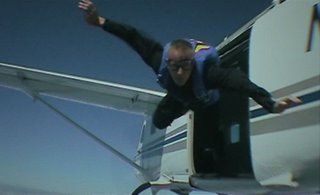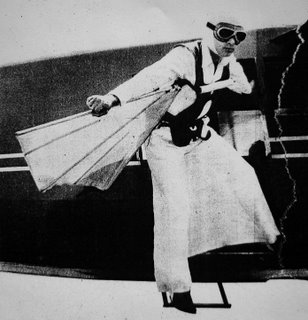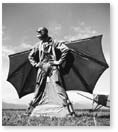 Why is this man running? One explanation is that he, Jay Stokes, is in a hurry to get from his parachute to a plane so he can go back up in the sky and jump out again, land, and hurry to get from his parachute to a plane, so he can go back up in the sky, etc. I'd have said ad infinitum instead of etc., but Stokes seems to have stopped after the 641st time.
Why is this man running? One explanation is that he, Jay Stokes, is in a hurry to get from his parachute to a plane so he can go back up in the sky and jump out again, land, and hurry to get from his parachute to a plane, so he can go back up in the sky, etc. I'd have said ad infinitum instead of etc., but Stokes seems to have stopped after the 641st time.The clock, you see, had run out. This morning, after 24 hours, Stokes set a new record for jumps in a single day, breaking the previous one, also set by himself, of 534. The difference alone is more than all but a few skydivers have made in a day. Of course, a more impressive feet would be to break a record currently shared by myself and a few others: Least number of jumps in a day. How ya gonna top that one, Mr. Stokes?
Another explanation for the hustle, is that Stokes is running from his wife. As he told me before the event: "My wife’s about to kill me, she wants to throttle me when I talk about this. She supports me but she knows I need to stop. If I can break 600, there's nothing left to prove. Of course, I’ve said that at least two or three times before. If 400’s doable, why not 500? If 500's doable, etc." Since Stokes surpassed the mere 600 jumps he was aiming for by so much, the new record may turn his mind to trying 700 sometime in the future. Whether he'll be able to set a new record for most number of jumps while maintaining a marriage remains to be seen.
Other points of interest:
To take off, reach altitude, and return to the ground in under two-and-a-half minutes, the pilots had to be as good at flying as Stokes was at jumping. "When they kick me out, they nose over—it looks like a crash—then they pull up and drop in and land," Stokes said. "For the pilots I've selected, it's normal."
Stokes has a rigged rig that allows him to spiral down to ground faster. "It’s something I added in, a secret thing . . . a mechanical advantage."
Stokes had three planes going and 20 people on the ground working for him. 25 "systems" were cycled by six packers working in four hour shifts. Two people helped Stokes out of his harness when he touched ground while another pair fitted him into the next one soon after. A special forces medic made sure he was never losing it. "If it looks like I’m doing something silly, a sharp turn as I'm coming in to land, this guy knows what questions to ask."
As for the question Stokes is asked all too often—"Why?"—he says the following: "When you're dong this, you question yourself. 'Why am I even here?' What helps me is I’ve done that four times."







